May 5, 2022. Everyone has heard of Tahiti and Bora Bora, but French Polynesia’s Gambier Archipelago is far less known. According to a Polynesia tourism guide, just 40 boats per year stop in the Gambier region. Four GLYWO500 Rally boats sailed directly from Panama (Saga, Pom III, Impossible, and BioTrek). We were among the first boats to arrive since the pandemic closed Polynesia in 2020. There are a few other boats at the anchorage near the town of Rikitea; some stayed here when the pandemic hit, and others are liveaboards, whose owners work on the island.
Alert to BioTrek-Sailing YouTube followers: Internet was almost non-existent in Gambier, explaining why no Youtube videos have been posted. There will be videos posted when we have fast enough internet.

The Gambier Archipelago is a single atoll. The surrounding reef is disrupted in two places, creating two entrances to the lagoon. There are mountainous islands inside the atoll and sandbars on the surrounding reef. The longest sandbar forms a natural runway, so it hosts the airport.
The Marquesas group is the common landfall for yachts crossing the Pacific, as it is on a straight downwind route. The Tuamotus, between Marquesas and Tahiti, are donut-shaped atolls. The more developed Tuamotu atolls have resorts and are common destinations for cruising yachts. The Gambier group combines the best topography of French Polynesia, with mountains to hike and turquoise lagoons protected from wind and waves. The climate is milder, as they are further south than the Marquesas; it is never oppressively hot, and evenings are cool.
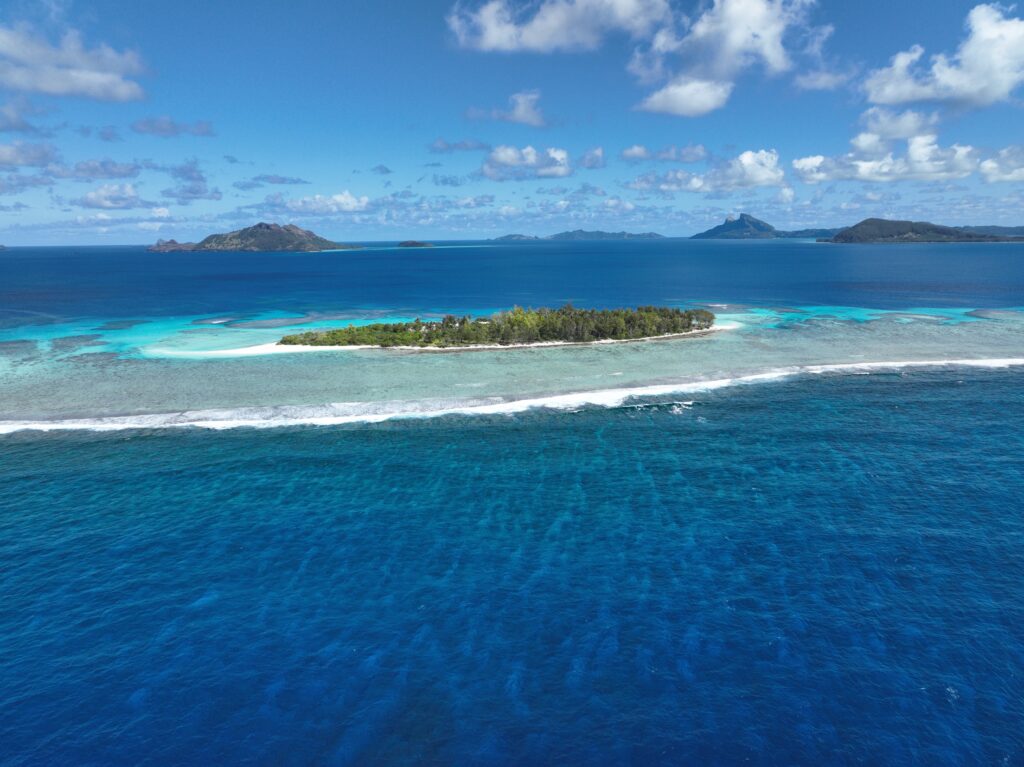
We travelled 4000 nautical miles directly from Panama to the Gambier. We started out with two other boats: Pom III (French; another 5x) and 2 Canoes (Canadian), who turned toward Galapagos after the first few days out. Impossible, an Outremer 45 (French) also chose Gambier because of a cat on board. Saga (French), like BioTrek, is on their second round-the-world, and they had suggested the Gambier as an interesting detour. Saga sails number one of the new model Outremer 55 and stopped in the Pearl Islands south of Panama en route. We kept in satellite email contact with these four boats for our crossing, sharing positions, weather, and wave conditions, as well as notes on fishing and meals. On board BioTrek, Pierre and I were joined by new crew Mia, from Virginia Beach, USA, and Pierre’s racing buddy Robert, who had crossed the Atlantic with us, and, of course, our cruising dog, Tiller.
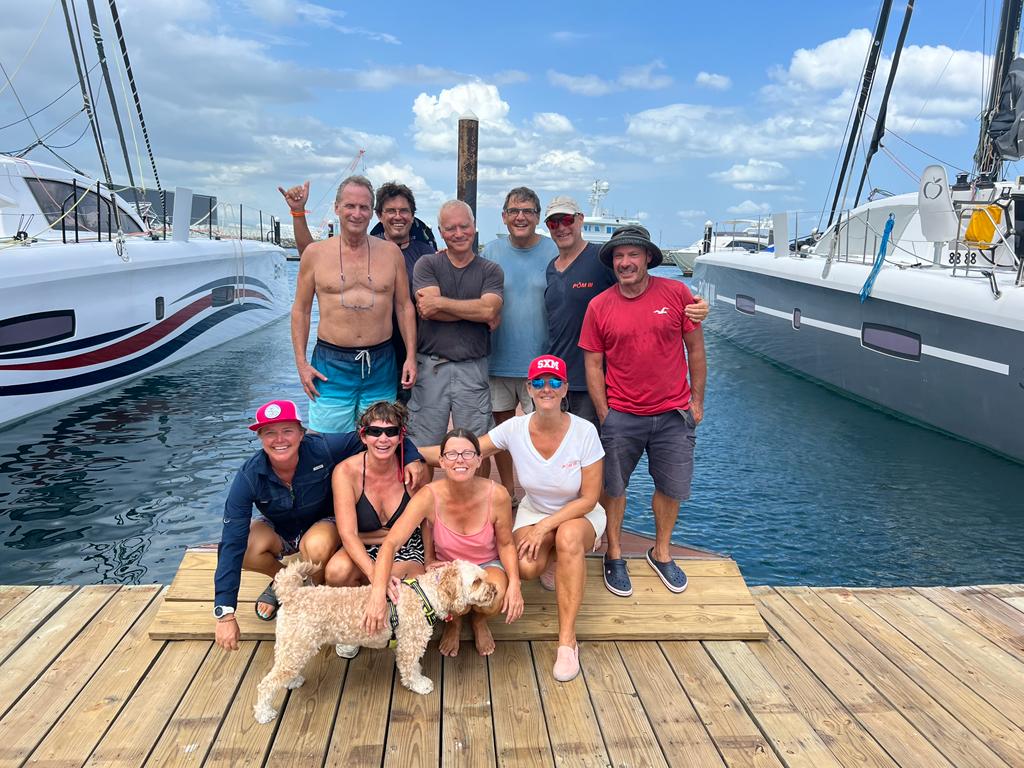
We had nice wind when we left Panama late on the afternoon of March 14, and all was well. Then, on Day 2, our B & G Zeuss went dark; that is the large navigation system we have at the outside helm station. It controls radar and various navigational functions. Pierre tried everything to repair it, but it was dead. That meant we did not have radar or navigation maps at the outside helm. Always with backups, our Timezero navigation maps inside the boat were perfectly functional, so we were not greatly affected. We would most miss our radar during some dark and stormy nights. But, at the beginning of the trip, sailing was smooth, and we had a full moon.
The trip to the South Pacific means crossing the doldrums around the equator, and finding wind is the main strategy in early route planning. On Day 2, we also lost satellite communications, meaning we could not get weather. That turned out to be our GMN satellite internet provider accidently pulling the plug. A call to them with our second emergency hand-held satellite phone solved that problem. A call to Commander’s weather, a weather router, also gave us rolling weather predictions. Our regular communication was back a day later.
The early part of the crossing was with calm following seas, tons of wildlife: whales, dolphins, sea birds, and fish. The first day, I put out three fishing lines, and three tunas hit at the same time—what a commotion on board! We landed all three big-eye tuna, kept two, and let one go. The sushi was amazing, and I have made fried fish, coconut fish, fish cakes, and ceviche.
In the calm waters near the equator, we often rolled the headsail and stopped the boat for a swim. We always throw a floating rope to hold for safety, and because the boat is typically still moving at about one knot. Since Tiller can’t hold the line, we attach a rope to her harness, so she can stay attached to the boat and cool off too.
As every mariner knows, it is important to celebrate King Neptune and give gifts to the sea when you cross the equator. The plan was that the men would dress as women and the woman dress as men. But, as we approached the equator, it was clear the big event would be the middle of the night during Mia’s watch. Mia and I put on pirate costumes and gave Neptune rum and Pringles. Robert got up and helped join in the fun. Pierre had said he did not want to be awakened, so we had a doll effigy for him. Our celebrations will make it onto our passage YouTube video.
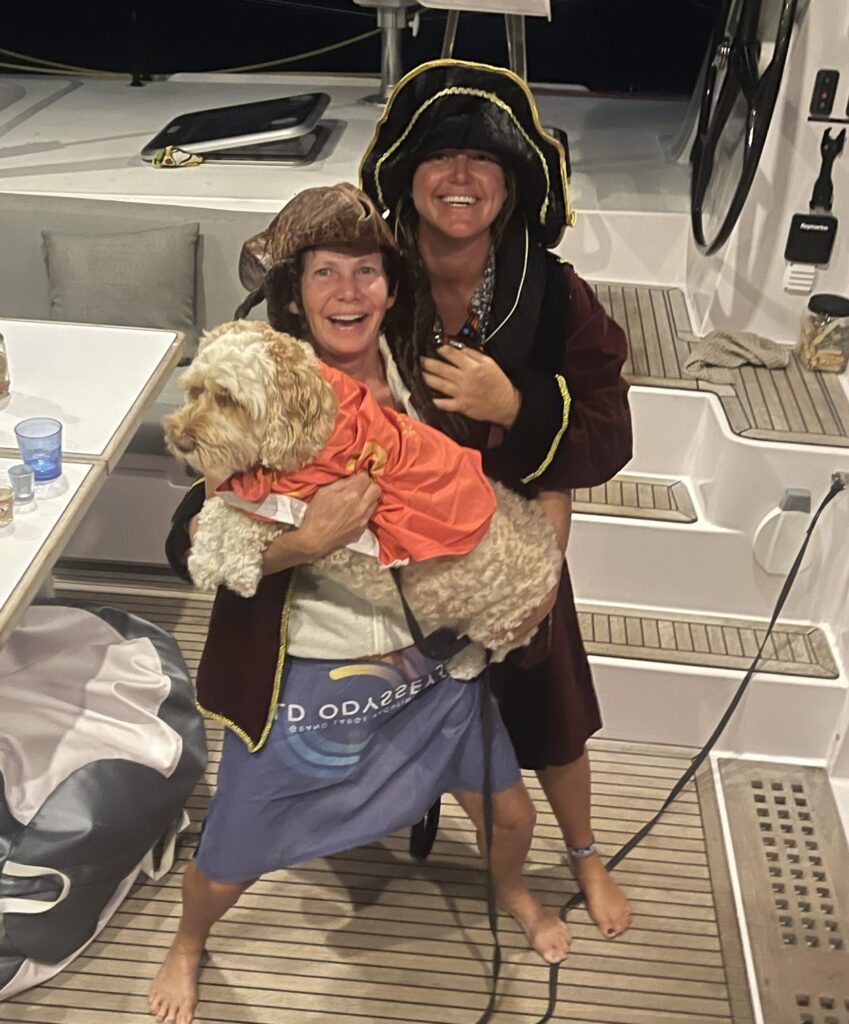
While we did not stop at Galapagos this time, it seemed that Galapagos came to us! As we sailed south of Galapagos, orange-footed boobies visited the boat, riding on the front crossbeam. At one point, eight birds were fighting for the prime spot on the bow sprit. After taking pictures, we tried to chase them away to reduce the mess on the boat. They were not scared, and I had to use a broom to get them to leave. Tiller barked at those balancing on the port bow handrail, and they simply threatened to peck her head, so I held her back.
About a week into the passage, the sea conditions changed since we were further south in the trade winds, now with the beauty of sailing in perfect conditions. As we passed the halfway point of our trip, the seas became large (10 ft) and confused, and the winds were fickle, constantly changing direction. This meant constant sail changes—putting up our large gennaker or taking it down to roll out the genoa. We could not use the spinnaker, as we were on a beam reach.
One day, Pierre noticed that the lashing on the gennaker had given way, and the sail had started to slip down the inserted forestay. If we furled the sail, we would not be able to fix it at sea, because it would need to be unrolled and spread out. So we slowly dropped it onto the foredeck, with all four of working to make sure it did not fill with wind and go overboard as it dropped and tying it down to ensure it would not billow overboard. Once it was tied down, we all worked to slowly hand roll the stiff sleeve back up the forestay, and re-lash the head of the sail. Pierre used a clamp on the edge we had just worked, to ensure it did not slide back as we worked it up. With all four of us working together, we managed to re-hoist and keep sailing with it. Teamwork!
This was not a leisurely sail across the Pacific. Sailing long distance fast means the boat is the focus of everyone on board. The three other boats sailing with us (Saga, POM III, and Impossible) had the same conditions a few hundred miles north of us. The three larger boats were sailing between 240 and 280 miles per day. Impossible is a smaller catamaran and was sailing around 170 miles per day, which is still pretty good mileage! When the boat is constantly moving along at high speeds of 10 to 14 knots, sometimes surfing down waves at 18 to 20 knots, a mistake can mean a blown-out sail, an injury or other disaster. Pom III and Saga had each blown out a head sail in the rough seas, an expensive handicap for the trip. When the wind increased above 20 knots and steering the boat was difficult with the larger head sail, Robert or Pierre hand steered so that we could keep the speed up before reducing sail for the night. At night, we changed to a more conservative sail plan, where the boat did not need as much constant attention, especially in these very dark cloudy sliver-mooned nights.
Aside from all that is involved in sailing, every day we check the boat carefully to detect chafe on ropes before they break and monitor energy and water. Morning means cleaning flying fish off the boat, as the pigmented scales make a mess if they are stepped on. BioTrek is like a small city; we make our own water and must monitor energy usage. In the morning, we huddle in front of the latest weather download to discuss sail choice. When the seas were rough, there was little time for reading or anything else. The routine was taking care of the boat or sleeping. Although we had watch schedules, we modified things during the day when we saw someone was tired. Robert wrote to his family “these crossings are not easy. Mentally and physically exhausting. Always sleeping with one eye open and ears perked.”
During our crossing, we ran our watch schedules on Universal Time, because we were crossing four time zones, and I timed meals by the position of the sun. No jet lag when travelling by boat!
Tiller’s excitement was at night when flying fish jumped right into the cockpit. Tiller loves to play with them as they flop around on the deck. She picked them up very gently, not hurting them at all, and I threw them back into the sea in good health. Tiller always knew when one had landed in the cockpit and helped sniff out fish that land in odd places, such as the bag that holds all the lines at the helm. Every crew member had their contributions during our trip!
About 1000 miles from destination,Saga lost their autopilot and had to hand-steer. To me, that seemed too awful to contemplate. On the new Outremer 55, the wheel position is moveable, making the task of hand steering a bit easier, and they could position it towards the interior where they could hand-steer from the protection of the sheltered cockpit. Still, hand steering at night with no moon, guided only by instruments and not visual cues could not be fun. On BioTrek, Pierre has already installed a spare autopilot so that we never need to cope with such an awful situation.
Another incident we had at sea was with our fresh water. I am constantly monitoring the level in the port and starboard tanks and noticed that both had rapidly emptied from half full . We checked the sinks, toilets, and showers to see if there was a tap dripping, even checking the crew cabin in the starboard locker but could not find leaks. We checked the water tanks. Pierre closed off the port and starboard water systems to narrow down the problem. Still no source of the leak. Pierre concluded that we were overlooking something – then remembered, what about the shower on the starboard transom? Yes, it was leaking, probably from waves pounding. The simple solution was to turn off the valve.
The last five days of our trip were very challenging, with large seas and winds up to 40 knots. We passed through two low pressure systems, each rotating clockwise, since we were south of the Equator. Between the two systems, we crossed a calm area where we needed to motor. The first low, with sustained winds of 40 knots and intermittent squalls, was easier to manage, because the worst of it was during the day. We put in a second reef and changed the genoa to the staysail.
Then, between the two lows was a calm, and I put out fishing lines again. As the wind started to pick up, we were going the perfect speed for fishing, 8 to 9 knots, but still no bites. I have three rods and had put all three out: two with home-made blue squids and one with a tuna plug. I changed the plug for a heavy yellow squid lure on my best rod, with a two-speed reel. Five minutes later, we heard the joyous whine of the line running out. The fish that stuck the lure was so heavy, Pierre had to land it for me while I manned the gaffe. We landed a 54-inch wahoo. It looked like a monster, but its sweet white flesh was divine. We still have lots in the freezer!
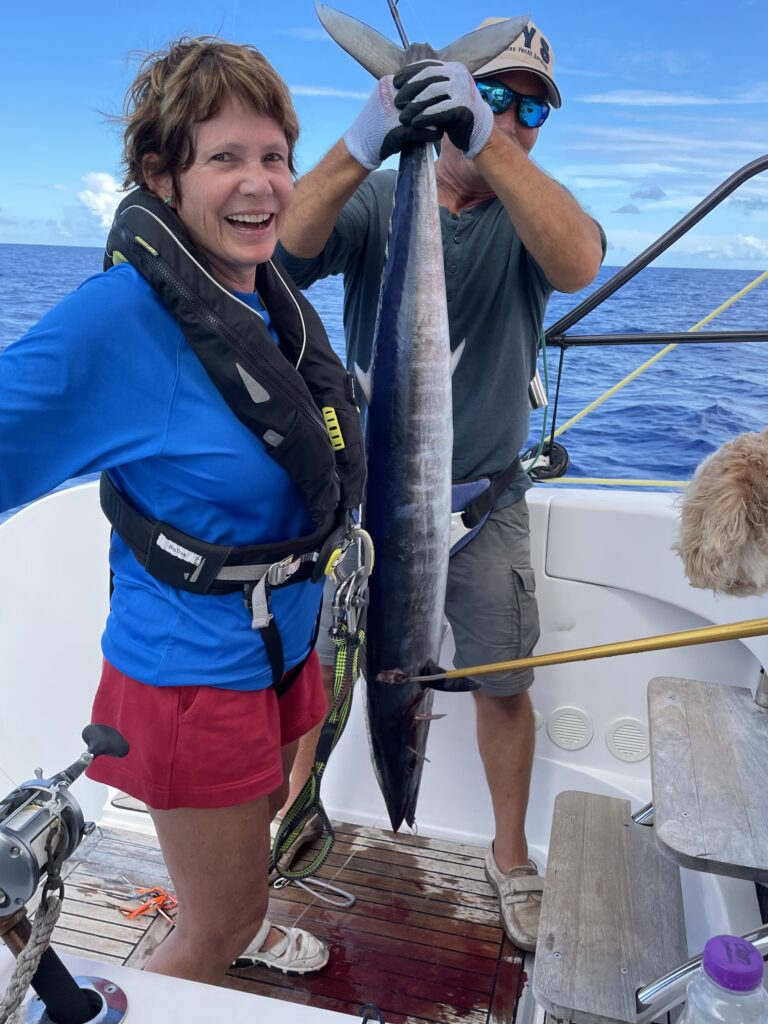
We entered the second depression late in the day, and the wind had switched north, so we could head straight to destination. It was a dark moonless night, and we hit an unseen storm cell, despite stars all around. Remember, we’d lost our radar! The wind went up to 40 knots while we still had the genoa out. Pierre was outside in the driving rain, with the boat sounding like a freight train and keeping a sustained speed of 15 to 20 knots. As soon as worst of the squall passed, with all hands-on deck, we quickly put a second reef in the main and changed to the stay sail. The waves built rapidly, and sleeping was all but impossible for all. We thought of poor Saga ahead of us, still hand steering.
All the rough weather sailing conditions that we endured in the last several days of our crossing were forgotten upon arrival, with the striking beauty of this region. We enjoyed water sports and camaraderie with the three other rally boats here. The local people were very friendly with three ways to say hello in Mangarevan, the local language. Everyone in Gambier speaks French, and the young typically speak French among themselves. Swimming shallow tropical reefs near the atolls that have sea surge was like swimming in an aquarium, with a multitude of colored fish. Some of the reefs further inside the atoll were alive and well, with other shallow ones starting to show signs of bleaching. The main business in Gambier is black pearls, and there were pearl farms everywhere. There were superb pearl necklaces on display at the local restaurant on the main island. All in all, a fabulous landfall after Panama.
We’ve now reached the Tuamotu region and with some internet. I’ll be posting videos when we have a strong enough connection.
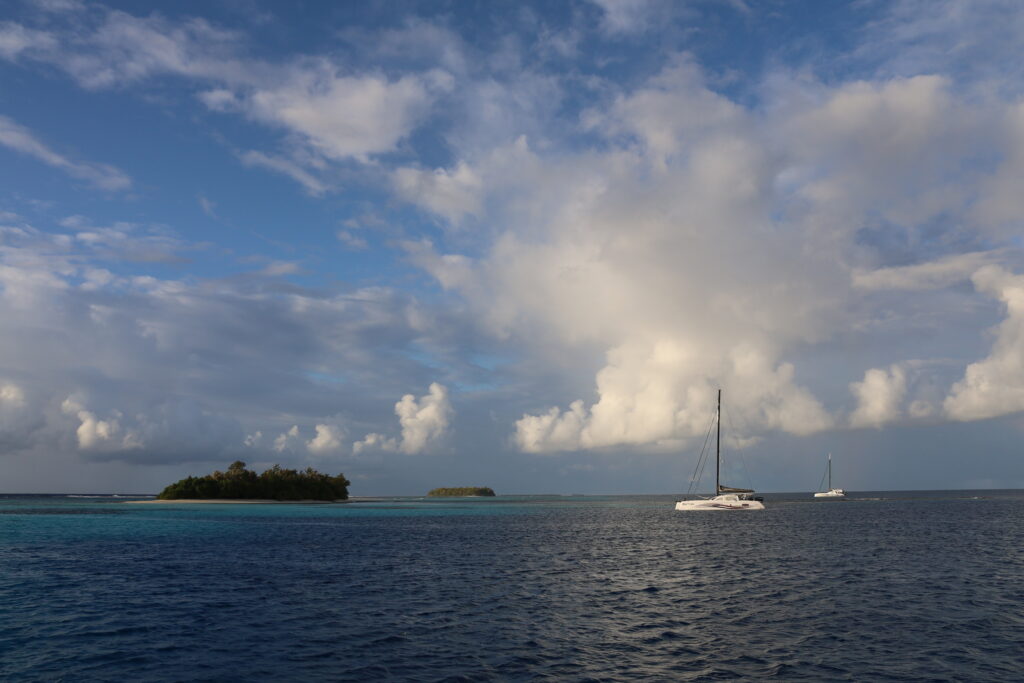
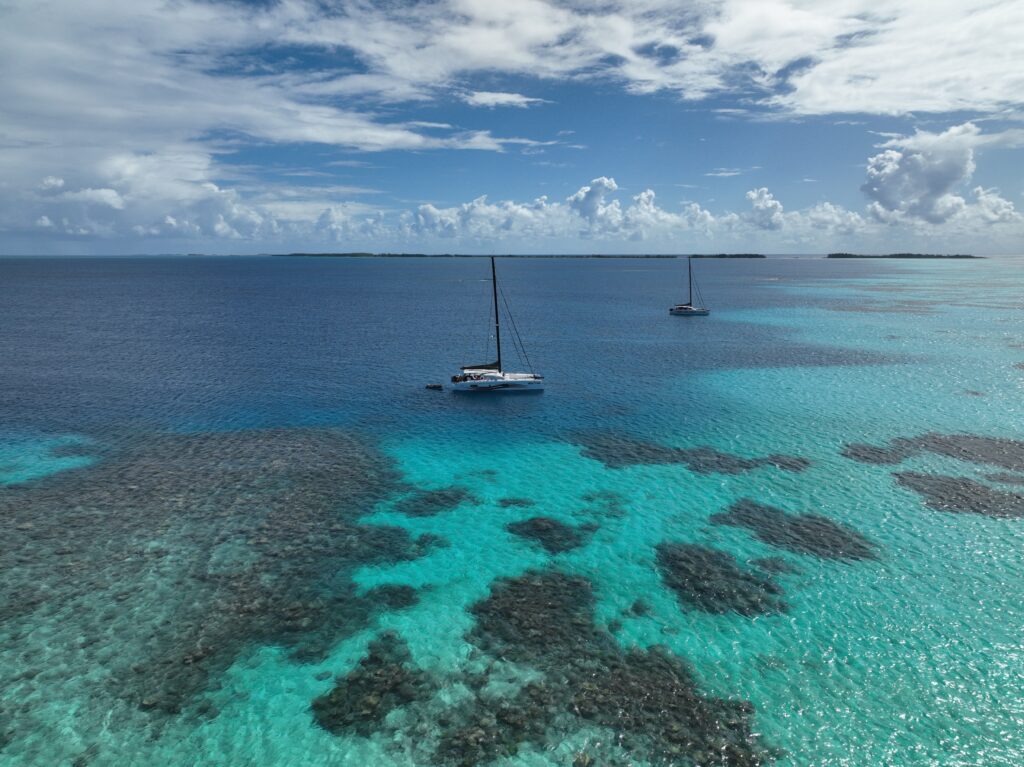
Thanks to Loic from Saga for the drone views. Our drone was lost at sea.
Thank you for such a good explanation.
Sailing a long passage can be a tough experience you do not pull your punches so feels far more realistic than the romantic tales we often see
Very Nice. On est impatient d’un apprendre plus sus les Gambiers et Tuamotu…
Sorry about the Drone. I thought Pierre was a better pilot than that..
Sounds like quite an adventure! Everyone looks happy and relaxed. The book Tiller will write will be amazing.